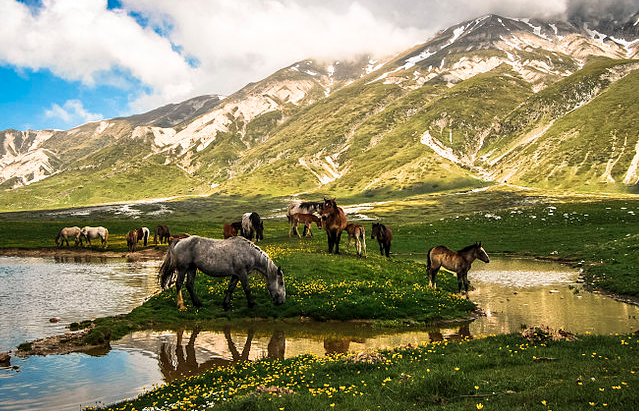
Altopiano di Campo Imperatore
This post is also available in:
 Italiano (Italian)
Italiano (Italian)
In Abruzzo, at the heart of the Gran Sasso range, surrounded by some of the highest and most suggestive peaks of the Apennines, there is the Campo Imperatore tableland, named the Tibet of Abruzzo.
This vast valley was created from the work of floods and glaciers that slowly shaped the morphology of the slope, creating an unique landscape , where plains and slopes alternate without interruption for more than 26 km at a variable altitude of 1500-1900 m.
The vastness of the place is enhanced by the exclusive presence of herbaceous plants that made it a perfect place for grazing and transhumance. Today, besides summer alpine pasture, the tableland is renowned for being one of the most suggestive ski areas in the Apennines, in winter, and , in summer, a popular hiking route.
Its amazing flora summons tourists and enthusiasts from all over the world. The rupicolous flora can be found in screes and rocky fissures, with elegant Alpine poppies (Papaver degenii and Papaver julicum), the rare edelweiss of the Apennines (Leontopodium nivale) and genepi (Artemisia umbelliformis subsp. eriantha). Many other rare flowers and unique species can be found in this mountain environments, collaborating with more common flowers to the extraordinary and spectacular flowerings that in spring and summer fill the infinite plains with colour: Alpine saffron (Crocus albiflorus), together with Scilla bifolia and Gagea fistulosa; thyme, clovers, buttercups, anemones, pasque flowers, gentians and unusual species like Valeriana tuberosa or spontaneous orchids, when the season is at its hottest and lushest. Among the many endemic species there are Cynoglossum magellense, Saxifraga porophylla e la Viola eugeniae subsp. Eugeniae, only found in the Apennines, with a small bearing but an exuberant flowering, able to cover entire fields for many kilometres.
This post is also available in:
 Italiano (Italian)
Italiano (Italian)



